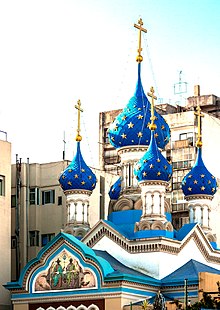User:Romavich14/sandbox
This article has multiple issues. Please help improve it or discuss these issues on the talk page. (Learn how and when to remove these messages)
|
| Total population | ||||
|---|---|---|---|---|
| 250,000 | ||||
| Languages | ||||
| Rioplatense Spanish, Russian | ||||
| Religion | ||||
| Christianity, Judaism, Atheism, Agnosticism and others | ||||
| Related ethnic groups | ||||
| Argentine people, Russian Brazilians, Russian Chileans | ||||
Currently there are 250,000 people of Russian origin living in Argentina, mostly in Buenos Aires and Greater Buenos Aires. Many arrived to Argentina between 1880 and 1921, while a smaller part of the community settled during the 1990s.
History
[edit]First wave
[edit]In the late 19th and early 20th centuries, various groups of people have emigrated to Argentina from Russian Empire. From all of the immigrants who came to Argentina in the period between 1901 and 1920, Russians ranked 3rd in abundance. By ethnicity, the immigrants primarily included Jews, Volga Germans and smaller groups including: Poles, Finns, and Ukrainians.[1] By 1910, Argentina's population was approximately comprised of 45,000 Germans. During the 1880's, many South Slavs including Bulgarians, Serbs and Montenegrins settled in Argentina, looking for Catholic patronage. Diplomatic relations between Russia and Argentina were successfully established in 1885.
Second wave
[edit]Since 1890, a wave of Jewish emigration followed and by 1910 the Russian-Jewisih population approximately amounted to 100,000 people. The emigration was aided by Baron Hirsch Society to support the Jewish community.
Third wave
[edit]
Following the call of the recruiters, many seasonal workers and peasants came from western Russian regions and settled in Argentina. One of the prominent Russian representatives of this period was an extraordinary ambassador of the Argentine Republic, S. Alexander. He served as an ambassador to Brazil, and before that, as former Minister Resident to Montenegro. While travelling along the east coast of Latin America, he published an original work "In South America", thanks to which Orthodox Christianity was introduced in Argentina. On June 14, 1888, the first South American Orthodox Church was opened in Buenos Aires. This temple was opened on September 23, 1901 in Brasília with the assistance of Via Superior Gavrilovic tiled Constantine (1865–1953). It served as a place of mutual support and was named after the Holy Trinity Cathedral. It was built in the style reminiscent of 17th century Moscow churches under the assistance of academic MT Transfiguration and the direction of Norwegian Argentine architect, Alexander Christopherson (Spanish: Alejandro Christopherson).
After the events of 1905, "Russian emigration" to Latin America has tripled with respect to previous twenty years. The emigration was not restricted to Jews and Russians, but also included Ukrainians and representatives of other nationalities. The amount reached 120,000 people, putting Russian immigrants 3rd in abundance after Spaniards and Italians.
Fourth wave
[edit]After the Russian Revolution and the start of the Russian Civil War, many White émigrés settled in Argentina.[2] They mobilized south through Crimea, Istanbul, and then from Balkans and Western Europe. Since 1926, 16 churches were opened in South America, a Cathedral was built in the northern part of Buenos Aires and a few Cossack residences were established.
During the breakout of World War II, many shared anti-communist views, however the overwhelming majority of Russians living in Latin America, shared pro-Soviet sentiments. After the recovery of Patriarchate Institute in Soviet Union under the rule of Joseph Stalin, sympathy increased. Ultimately a church of the Moscow Patriarchate was opened in Buenos Aires. After the war, there was a new exodus of emigres from Europe. In 1948, President Juan Peron issued a law for the admission of 10,000 Russians. Of the 5,000 to 7,000 people that settled in Argentina, many were former prisoners of the Nazi concentration camps.
Among these people, there were 10 priests of the Russian Orthodox Church and a few hundred soldiers. Many former army personnel lived and died in Argentina including: eight generals, a few dozen colonels, about twenty Page Corps, about forty Knights of St. George, more than twenty Imperial Russian Navy personnel and about 250 cadets.
In 1969, an Archbishop of Leontius, Vasily Konstantinovich Filipovich, came to Buenos Aires from Chile in order to prevent a split between the Soviet and the monarchist-minded congregations. He died in 1971, and the split was eventually overcome only in the 1990s.
Fifth wave
[edit]The last wave of emigration coincided with the Perestroika, as many Russians were searching for work and permanent residence.
In present time, Archbishop Platon, Vladimir Udovenko, is the bishop of Argentine and Diocese of South America.
Notable people
[edit]- Gerardo Sofovich
- Coti Sorokin
- Oscar Marincovich
- Luis Ziembrowsky
- Eugenio Zagortski
- Valentina Sharapova
- Lola Melnik
- Stepan Erzia
See also
[edit]- Russians
- Russian diaspora
- Argentina–Russia relations
- Immigration to Argentina
- Cathedral of the Most Holy Trinity, Buenos Aires
Notes
[edit]- ^ Ehrenhaus 2012, p. 4
- ^ Ehrenhaus 2012, p. 66
References
[edit]- Ehrenhaus, Sofía (2012), Inmigración rusa en la Argentina (PDF), Buenos Aires: Historia Visual, Museo Roca
Further reading
[edit]- Claudio Flores, Fabián (2001-08-01), "Cadenas migratorias, redes sociales y espacios religiosos: el caso de la Colonia Ruso-Alemana a la Villa Adventista", Scripta Nova. Revista Electrónica de Geografía y Ciencias Sociales., 94 (23), retrieved 2014-01-04
{{citation}}: Unknown parameter|trans_title=ignored (|trans-title=suggested) (help) - Adrián O'Dwyer, Pablo (2006), Tierra prometida: la colonización judía en el Alto Valle del Río Negro — la colonia rusa, Ediciones de la Universidad Nacional del Comahue, OCLC 836991066




